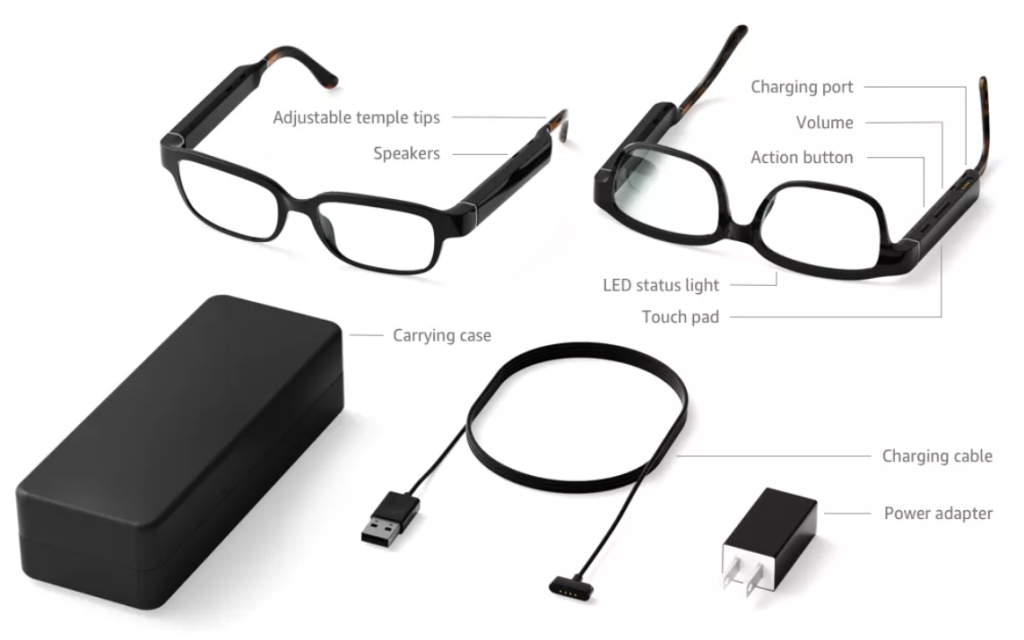Sign up for Greg’s email list here
We’re all going to be wearing smart glasses. Someday.
Based on patent filings, leaks and acquisitions, it’s evident that some of the biggest tech companies – Apple, Microsoft, Amazon, Snap, and Facebook – are all working on new technology and innovation that will change how we think about wearables, hearables, and an A.I.-assisted lifestyle. Just this week, Mark Zuckerberg presented Facebook’s plans for smart glasses in 2021, with augmented reality glasses coming soon after.
This week Mark Zuckerberg said many companies are taking shortcuts when it comes to building AR glasses by basically showing some heads-up information. He said: “I call that ‘putting an Apple Watch on your face.’” Well, today we can at least get an Alexa assistant on our faces.
Yes, I wore Google Glasses. Yes, I wore Snap Spectacles. Yes, I desperately want a pair of Nreal Light Augmented Reality Glasses I tested at CES. Yes, this is a review of the new Amazon Echo Frames. Yes, I will buy the Facebook glasses and cannot wait for Apple’s rumored glasses to come out. That’s all on brand for me, right?
But if you know me, you know I love experimenting with these near-term innovation products NOT BECAUSE I’m dying for technology on my face. Rather, it’s because I’m fascinated with these small steps leading to the killer, smart, face-mounted device we will all use in the future.
Think of all the smart phones that existed before the iPhone was introduced in 2007 and changed the paradigm of what a phone would be by 2020 and how our education, work, and lifestyle would revolve around these black mirrors.
So that’s how I view today’s smart glasses experiments… they are baby steps to a paradigm shift I believe is coming. Disclaimers aside, let’s chat about Amazon’s new smart glasses!
Amazon Echo Frames

Amazon’s Echo Frames are the most affordable, effective, and consumer-facing look around the corner of where smart glasses trends are headed. They look good. You can’t tell they are smart unless you’re told. And they are a remarkable step forward for getting our faces out of our phones and wrists in daily life.
Available to consumers through Amazon’s invite-only Day 1 Editions program, Amazon Echo Frames are pre-priced at $179 (full retail will be $249), plus the cost of prescription lenses (~$100, depending where you order them). So not exactly Zenni prices, but certainly cheaper than Snap Spectacles ($380) and Google Glass ($1500).
Frames have Alexa built-in, plus Siri or Google Assistant, and rely on a bluetooth connection to your phone for data. Similar to other Eco devices, Alexa is always listening for the ‘wake word,’ which then triggers A.I. assistant to spring into action and give you complete access to Alexa’s wide range of Skills, calls, drop-ins, and more. Or with a simple temple press, access Siri and its native access to your entire iPhone, testing, calls, apps and more. Same with Google Assistant on Android devices.

With four microspeakers and two beamforming microphones embedded in the stems, the audio quality is excellent except in heavy winds.For music, they are a little tinny. But the microphones are excellent for voice. I have to imagine Amazon’s engineers are exploring bone conduction audio for future iterations. But as long as you have the volume set low enough, they are pretty private.
In fact, the other day I was having a discussion with my wife and listening to a podcast at the same time. I’m a super nice husband. And I will not make that mistake again.
No screen! No camera!

The immediate initial questions I get asked about Echo Frames are: 1) Are you looking at me through a screen right now, and 2) Are you recording me?
No! Frames are hearables in the purest sense. A small light inside the frames tells you when you’ve activated Alexa by voice or the backup stem button, but otherwise there is no visual display to look at or through (these are not augmented reality glasses) and no camera.
As for the audio side of “Are you recording me?” – well, that’s a stickier answer. This is an Amazon product, after all.
Google Glass missed their PR window to educate consumers about privacy and use of its camera. Snap Spectacles attempted to inoculate privacy concerns by its placement of bright circling lights when they are recording.
This 1st edition of Echo Frames doesn’t include any forward-facing indicator when the microphones are “listening” or sending audio to your phone, but I assume that’s intentional — the microphones aren’t facing outward and aren’t designed to record.
However, there are valid concerns about how Amazon stores and uses all of its Alexa-based data and recordings. That same scrutiny can be applied to Frames. And like all Echo products, there is a manual “mute” button with red light indicator that it is not listening.
So after a month wearing Amazon Echo Frames off and on, how am I using them?

- “Dropping in” on my kids while they’re doing school in their rooms. We have Echo Dots in each room of the house, and it’s pretty great to quickly be able to call them down for lunch or ask how school is going.
- Talking on the phone, texting, listening to music and podcasts, and recording Marco Polos – as a supplement to my AirPods.
- Asking random factoids and information, like how many ounces are in a gallon – as a more intimate supplement to normal Echo requests.
Of course, this test period is taking place during a global pandemic. So practical use in “normal” times, including during a commute, working from an office, or doing extra curricular activities has yet to be fully flexed. I more or less never leave my highly-connected home, where I can count eight always-listening Echo devices, plus Google Home and Facebook Portal. And my Echo Loop smart ring. So they are a tad bit duplicative in this season of life.
My biggest issues?
Battery life. Man, these batteries are not good. Maybe 3-4 hours battery life, depending on how much you’re using them. There’s nothing like wearing dead smart glasses for hours at a time in the afternoon. So the trade off of Echo Frames not being bulky and obnoxious is you are trading battery life.
You also MUST have your phone around to use them. Just like the Apple Watch’s evolution, you can imagine future iterations of Frames having their own data plan. Leave your phone at home and just head out with your Frames. It will happen.
And lastly, I do think there are valid privacy issues to anticipate with the mainstreaming of hearables, particularly as people become more educated on surveillance and sousveillance as it pertains to audio recordings. Where Google Glass dropped the ball on proactive PR, others need to learn and start working ahead on normalization and privacy controls.
BONUS: Now when my phone rings my laptop, phone, Apple Watch, Echo Loop ring, and Echo Frames glasses all ring! The future is amazing, you guys! I’ll never miss a telemarketer spam call again.
Should you buy Echo Frames?
Probably not. They aren’t necessarily intended for general public consumption. However, they are the highest quality, most affordable, best looking smart glasses I’ve worn.
In fact, I genuinely like them. It took me a couple weeks to get prescription lenses, and now that I’ve got them I will wear them regularly.
On the other side, I mean… just look at these cool folks at the official Google Glass Meetup at SXSW in 2014…

So Echo Frames Edition 1 are not the must-purchase, but they are a step to where we’re headed.
Where are we headed?
As mentioned in the intro, I’m pretty bullish on smart glasses coming into the mainstream. When? It’s safe to say the next 10 years, although I predict it will be sooner.
I’m fascinated with the promise and value of smart glasses, including new uses we can only start to imagine, including…
- Notifications: Screenless and heads-up
- Real-time translation: via visual displays and/or audio
- Smart lenses: dynamically changing prescription, focal length, blue light, and UV protection
- Anticipatory A.I.: moving beyond notifications, reminders and lookups to offer proactive information, scheduling, and more
- Standalone data: We could conceivably not need to carry a phone at all by 2030.
- Augmented Reality: opening the digital layer of our world to its wearer for work, play, and daily use. Of note, Nreal is advancing this quickly.
Will the future look like Keiichi Matsuda’s short film, Hyper Reality (2016), experienced through smart glasses? We’ll find out soon enough.
